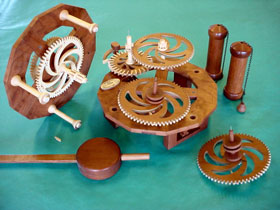
There’s something timeless about Jeff Arnett’s clocks and the pun is intended. His beautiful handmade, wooden wall clocks have an Old World look.
Jeff hand crafts each clock — including the gears and pendulum — using different woods and veneers that include oak, cherry, maple, mahogany, and walnut. A mechanical engineer during his day job, Jeff’s technical expertise, use of CAD systems, and experience making prototypes gives him the background to lay out and execute the complex workings of each clock. His woodworking skills do the rest.
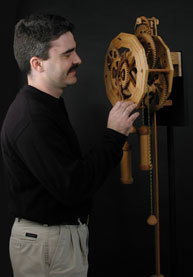
Jeff grew up on the lower peninsula of Michigan. When his wife wanted to get away from the snow, the couple first moved to San Diego. He always had an interest in woodworking, but his concentration on clocks started with a magazine article.
“I read about a guy who’d done some clocks out of wood, and being the engineer that I am, it really struck a chord,” Jeff recalled. “I said to myself, I can do the engineering part of figuring out how to make a clock out of wood, and then I can make the clock with the woodworking tools that I had. As it turned out, it does take some different tools to make clocks.”
Copying the magazine’s detailed description of the clock, Jeff made his own version. When it didn’t work, he started over from scratch and applied his mechanical engineering background to, as he puts it, “reinventing the wheel.” Non-digital clocks today are made from metal & and have been for a long time. But the first clockworks were made from wood and some are still running. Jeff thinks wood is actually better than metal.
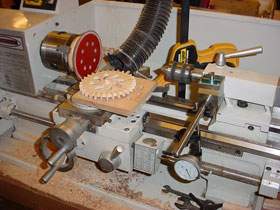
“Going back to my professional experience, I knew that, when designed right, plastic gears last longer than metal gears. Unless you overhaul it every five years, the oil in metal gears collects, gets gummy on the axels, and slows down the works. Wood has the same softness and resiliency as plastic. I honestly haven’t been running my clocks long enough to know, but because there really isn’t any oil, I believe they won’t have that problem. I am using a Danish oil finish and put a little bit of wax on the escapement (the thing that goes back and forth every second), but I really don’t use oil.”
Jeff admitted that, at the end of all the axles, he uses a 1/16″ metal pin that rides a nylon bushing. Unlike metal on metal, however, he contends that nylon on metal will never wear out.
“The design I have now is completely my own,” he explained. “Of course, I’ve now read quite a few clock design books and have gotten a lot of tips from them. But I have to throw 90% of them out the window, because they assume you are doing something from brass and steel. The general mechanics apply, but not the materials and manufacturing methods.”
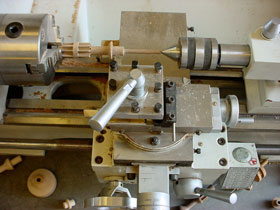
Two years ago, Jeff and his wife made the move to their present home in Phoenix, Arizona. The move gave them the slower paced and less expensive lifestyle they wanted. And his current shop — now set up in the garage — gave him the space to start building production clocks.
To show the precision of his woodwork, Jeff leaves the sides of his clockwork open. Because woods like oak would split under stress as gears, Jeff uses Baltic birch plywood with different wood veneers for the face, dials, and gears. All the gears are cut one at a time, but to make them consistent, Jeff created his own CNC router.
“Using the parallel port on my computer, the router instructions go to a box I devised that controls three separate stepper motors on an X, Y and Z axis. I’ve got a RotoZip in it, and when I set it up and get it going, it takes about five minutes to cut a gear. It’s just wonderful to sit there and watch it. It’s actually pretty simple to build and only cost me maybe $600. It takes some knowledge, but somebody could put a kit together, for the average Joe to build it. I’m surprised I haven’t seen any articles about this in the woodworking magazines. The only thing comparable is the large ShopBot, which I think sells for $5,000.”
Jeff has high hopes that his clocks will catch on. So far business has been slow, but he remains patiently optimistic.
“I’ve made 20 clocks so far. Each clock takes about 60 hours, and the retail price is $3,600, but I haven’t sold any at that price. I have them in art galleries right now on consignment all over the country. One of the dealers is planning on buying one outright for his showroom. But it’s kind of my struggle, trying to find the high-end market. I want to do the clocks because they are unique & but the uniqueness coupled with a high price makes them difficult to sell. At galleries, I get looked down upon because they don’t consider it ‘true art’ like a painting or sculptures. When I go to furniture stores, they already have their expensive grandfather clocks, which are not the same thing. So I’m still trying to find the right market. And if all you want is a clock you can pick one up for $20.”
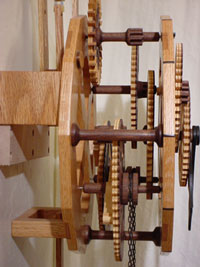
He’s thought about selling through online auctions, but he’s not sure he would reach the right clientele or how his galleries would react to competition. For the near future he’s thinking about designing a floor-model version & even though he realizes it would be even more expensive.
“Marketing is the brick wall that most people run into. You can get a lot of oh’s and ah’s, but you have to find the right person with the right amount of money in their pocket. Every product needs a niche and that can be a puzzler. I expect it will take a few years to fill the pipeline and get enough shown out there to have regular sales. Someday, I’d love to have enough business with one or two employees doing all the sanding, I don’t know when it will happen, but I’m hoping it doesn’t take me 80 years to make it.”





